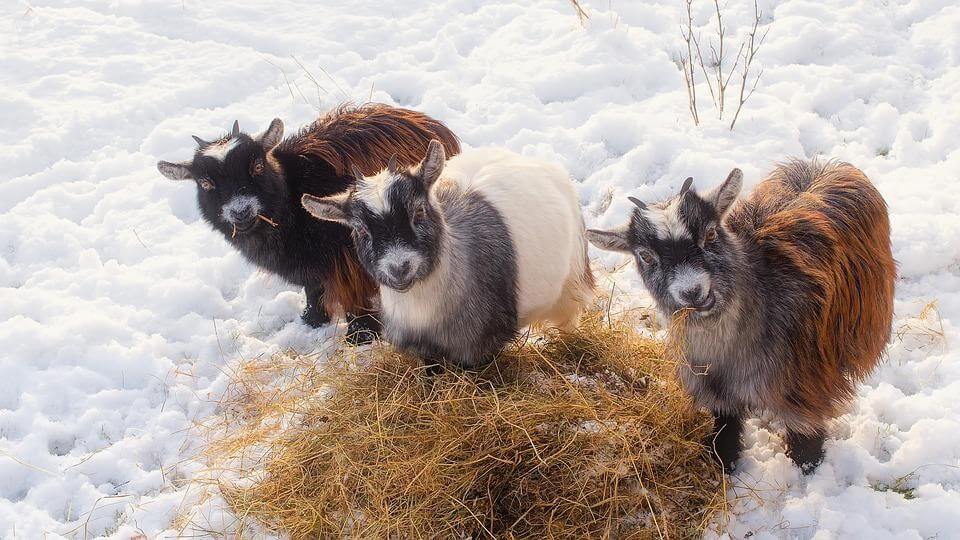Have you ever wondered how cold is too cold for goats and how to keep goats warm in winter? While they are technically cold-hardy animals that can survive low temperatures, some temperatures are unhealthy for them. Frostbite and hypothermia are concerns for goats in winter, especially the doelings and bucklings.
A healthy adult goat can survive in temperatures as low as -10° Fahrenheit and as high as 110° Fahrenheit. However, when things get way below zero, like they tend to do from time to time during the cold winter months, you might need to take certain steps to keep your goats warm.
In the wintertime, goats need access to hay. Also, do your best to keep goats dry. One way to do this is to have a draft-free but ventilated goat shelter for them. In addition, some goat breeds are more tolerant of the cold and more cold hardy than others. Consider breeds well-suited to your climate before adding more goats to your herd.
Use these tips on how to keep goats warm in winter and ensure they keep productivity levels up even during these freezing temperatures.
How to Keep Goats Warm in Winter
To avoid the negative effects of extremely cold weather, here are seven tips on how to keep your goats warm in winter.
1. Provide Goat Shelter for Winter
Cold weather is most dangerous with wind or water. If your goats get caught out in the cold without a goat shelter, they’ll not only get chilly, but they may also get wet. Providing them with a well-constructed and insulated shelter during the winter is one easy way to protect them from the elements. Consider these DIY goat barn ideas.
Without a good shelter, even your goat’s coat wouldn’t be enough to protect it against hypothermia. This is when the goat’s body temperature falls below its normal level. When this happens, the animal’s vital organs begin shutting down, and if left unchecked, the goat might die.
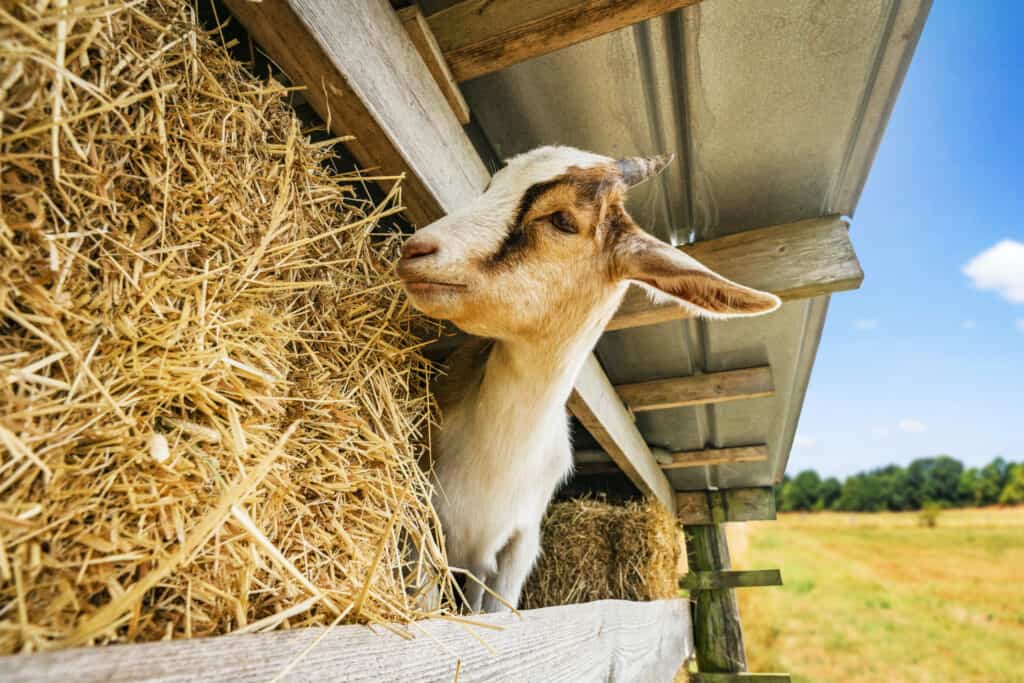
Another danger of not providing your goats with the right kind of protective shelter is that their fur can trap the cold water next to their skin. If your goats are left standing out in the cold and wet weather for long enough, the water might slip through the outer layer and soak through the hair. That effectively turns the goat’s protective coat into a deadly trap.
Signs the Goat is Cold
Once it starts shivering uncontrollably, you will know that your goat is at risk of hypothermia. It will also start to act lethargic. Goats that are wet will not dry off easily if they are too cold.
If you notice any of these signs, it’s imperative that you bring the specific goat in question indoors and try to raise its body temperature back to normal. You can do this by slowly feeding it warm water, covering it up in a blanket, drying it off, and generally keeping it where it’s warmer.
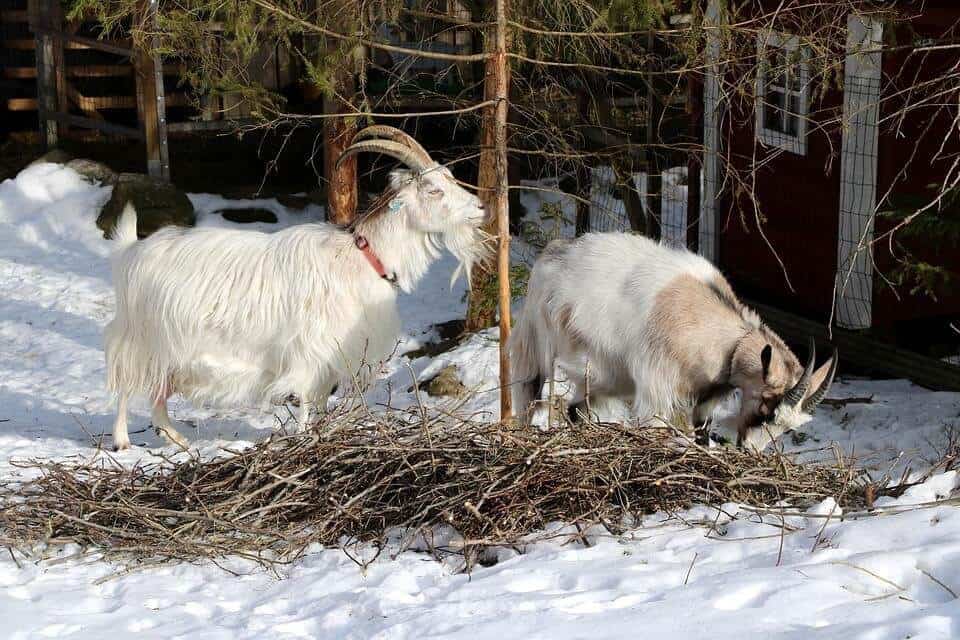
2. Insulate the Barn
No matter what your shelter may be, insulation can greatly impact the temperature inside. As is the case with most animal barns, they need to be well-ventilated. Not only does this ensure that the air within remains fresh as opposed to stale, but it could also minimize the spread of disease among your livestock.
Unfortunately, well-ventilated barns aren’t always the most insulated. Insulating a barn takes deliberate effort and might be slightly more expensive than many farmers are willing to pay. However, making sure that the cold air outside doesn’t get in and interfere with the warm air inside the barn is crucial if you live where it gets windy or temps drop very low.
Seal areas where you feel drafts to keep cold air out and insulate walls to counteract the effects of wind chill. Imagine needing to work in a freezing barn all winter long? That’s not something you would have to suffer through if you had a well-insulated goat barn.
3. Keep the Goats Hydrated
It’s good to drink lots of water to avoid dehydration whenever it’s very hot. While this might not seem like a problem you might face in cold temperatures, it’s an issue for many goats. The problem is that the water often freezes in cold temperatures which will not allow your goats to get adequate water.
As a result, the herd will drink less water gradually and slowly but steadily become dehydrated, which is just as dangerous to their health and life as cold temperatures. Goats consumption of feed is directly related to their consumption of water. If they aren’t drinking, they will stop eating. One way to mitigate this issue is to use a heater water bucket or submersible water heater to keep the water thawed during the winter.
You can do this by warming the water every day before putting it in the barn or simply providing heated buckets within the barn itself. If you give the goats fresh water from your house, do it several times a day.
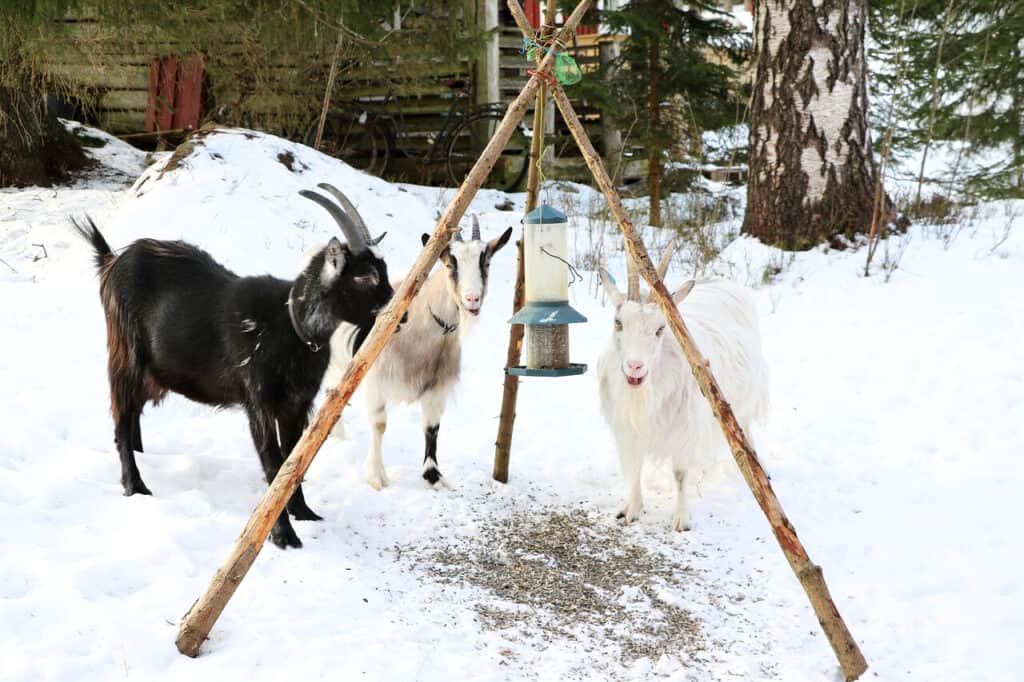
4. Keep the Goats Off the Cold Hard Ground
You have probably noticed that your goats are often more comfortable or prefer sleeping off the ground. Most goat breeds like to have deep bedding piles to lie on at night. Not only does this keep them off the hard ground, but it also helps with insulation.
Providing your goats with fresh, deep bedding such as straw or grass hay which they can sleep during the cold months is a great way of ensuring that they will remain warm through the nights. This is one of the most important steps to keeping your goats warm in the winter.
Proper bedding for goats is important. Thick layers of hay will help insulate the goats from the frozen ground, keeping them warmer. It will also enable the goats to surround themselves with it. By nestling in the hay, they will be able to stay warmer and expose less of their bodies to wind and cold.
Failing to do so could mean exposing them to the cold hard floor where the ground will slowly but effectively lower their core body temperatures and put them at risk of hypothermia.
5. Keep the Goats Well Fed through Winter
Farmers raising dairy and meat goats know that keeping their goats well-fed is the key to positive returns. As important as the right mix of feeds is to milk, and meat production, so is it to the goat’s well-being during winter.
Cold climates, however, call for a slightly different approach to feeding your goats. While they may get by on grain in most climates, goats need roughage when it comes to cold weather. This is one of the most effective ways through which they generate heat from the inside out.
Feeding your goats roughage such as hay or grass is essential to keep them warm during winter. Not only will chewing keep them moving and warm, eating large amounts of roughage will keep their rumens active which will keep their body temperatures up.
6. Keep the Goats Active
Unless it’s extremely cold, very windy, or raining, it’s often a good idea to encourage your goats to get out of the barn and onto the pasture, even during winter. Those few hours of exercise will help them generate heat by running around, alleviate boredom, and give them some level of social enrichment.
You can encourage your goats to move around the pasture by having a host of feeding stations throughout the property. Be sure to provide lots of roughage within the stations.
If you have a goat playground for them, they will enjoy romping around when it’s safe to do so. In addition to helping them be active, it promotes communication, helps establish their hierarchy (like a pecking order for chickens), and helps limit destructive behaviors.
7. Don’t Cover Goats with Blankets
Finally, as counterproductive as it might sound, it’s important to avoid covering your goats with blankets or other man-made warming materials unless they are on the verge of hypothermia and you need to bring their core temperatures back up.
The reason for this is simple. If you cover them with blankets, you will discourage their bodies from protecting themselves by growing the necessary thick winter coats. Goats will naturally grow a winter coat and if you cover them with blankets, their bodies will not feel the need to grow a nice thick winter coat to keep them warm.
How to Keep Baby Goats Warm in Winter
Newborn goats and kids are particularly at risk for frostbite and hypothermia. According to North Dakota State University Extension and Ag Research News, newborns often are hypoglycemic. This means they have low energy reserves and electrolyte imbalances.
Goats less than 48 hours old are at at the greatest risk for developing hypothermia, according to Charlie Stoltenow, North Dakota Sate University Extension Service veterinarian.
The best way to keep newborn kids warm is to provide indoor spaces for them and their mothers. This will keep them dry and out of the wind. If kids are too cold, their ears could suffer frostbite and their growth can be stunted. If you are able, provide newborns with heat lamps to get them through cold spells.
Why Keep Goats Warm in Winter?
When it comes to heat and cold tolerance, goats happen to be some of the most versatile creatures. Not only can they live below freezing temperatures, but they can also thrive in hot and arid areas.
The secret to this extreme adaptability to temperature variations is their double-layered fur. Goats have both an outer and an inner layer of fur. The inner layer is soft and fluffy, and it’s thick and warm enough to insulate the animal against extremely cold weather.
Their hair is designed to help the animal maintain its body heat. It does this by insulating and keeping both the cold and hot temperatures away from the goat’s body. The outer layer of fur isn’t quite as soft but coarse. This layer is designed to help protect the goat from the various elements.
Despite all these natural assets to keep them warm, goats, like every other land mammal, can’t survive being exposed to extremely cold temperatures. After a while, their body temperatures would drop to a dangerous low, which could have catastrophic results.
Baby goats are particularly at risk. In addition, goats of all ages that have pre-existing conditions such as an illness or pneumonia have impaired body reserves and may succumb more readily to very cold and windy conditions.
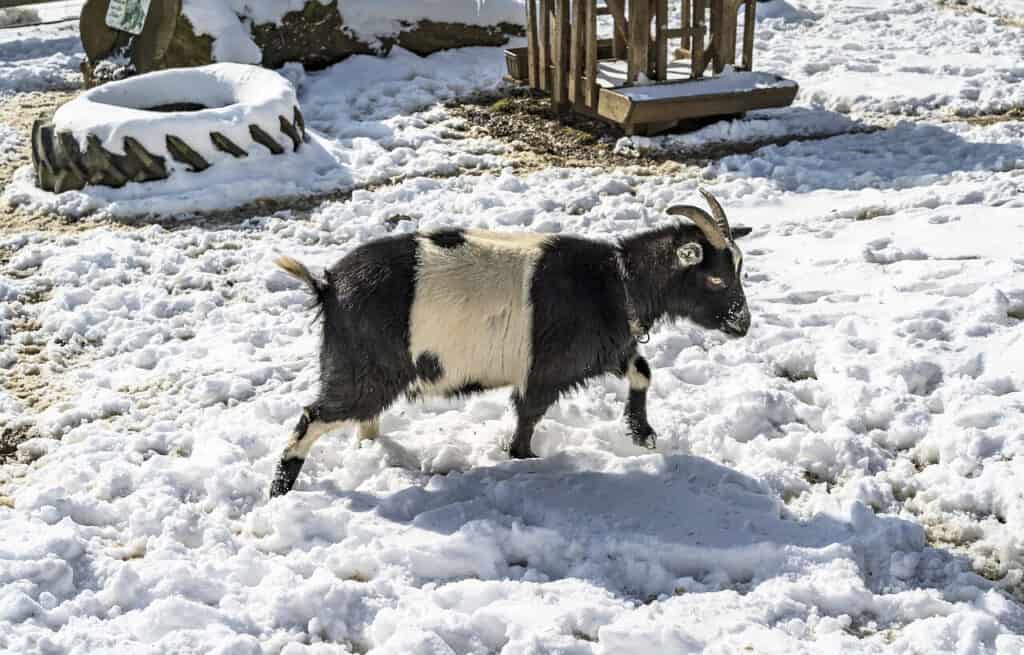
Keeping Goats Warm in Winter
Here are some reasons goat owners need to keep goats warm in winter.
- They could die: Without the necessary protection from the cold weather, a goat’s core temperature could drop to a fatal low. This is particularly true and easy for baby goats.
- They lose their desire to feed: When exposed to extremely low temperatures, baby goats lose their desire to suckle, which could lead to starvation. The same applies to mature goats. Farmers raising meat goats need to beware of this as their goats might lose quite a bit of mass during this period.
- Goats can get frostbite: Goats can get frostbite on their ears, tails, and legs. While the ears and tails may not be that big a deal apart from the discomfort for the goats, losing the legs could mean that you need to put the goat down.
- Reduced milk production: If you raise goats for milk production, extremely low temperatures could negatively affect how much milk they produce. If the goat is a mother nursing, it could potentially not produce enough milk to adequately feed its kids.
Cold Hardy Goat Breeds
The goats you own are the goats you’ll need to protect in the cold winter months. However, thinking proactively for the future never hurts. Consider your climate and your average winter highs and lows. It may make sense choose cold hardy goats if you live in an area with very cold winters. While you will still need to keep them warm in the winter, they will be better suited to cold temperatures than goats that thrive in warmer climates. Spanish goats tolerate extreme heat and cold and favor brush and weeds for forage.
Keeping Goats Warm in Winter
By planning ahead, you can keep goats warm in winter. Keeping them dry in cold weather is important. On sunny days, when the temperature is in the 30’s, it’s fine for the goats to romp around in the snow. Just be sure to use an old towel or something to dry them off before they go into their goat shelter for the evening. This will help prevent frostbite as the temperatures drop in the night.
If your does will be birthing kids during cold weather, be sure to have a plan for keeping the baby goats warm. They are particularly susceptible to freezing temperatures.

